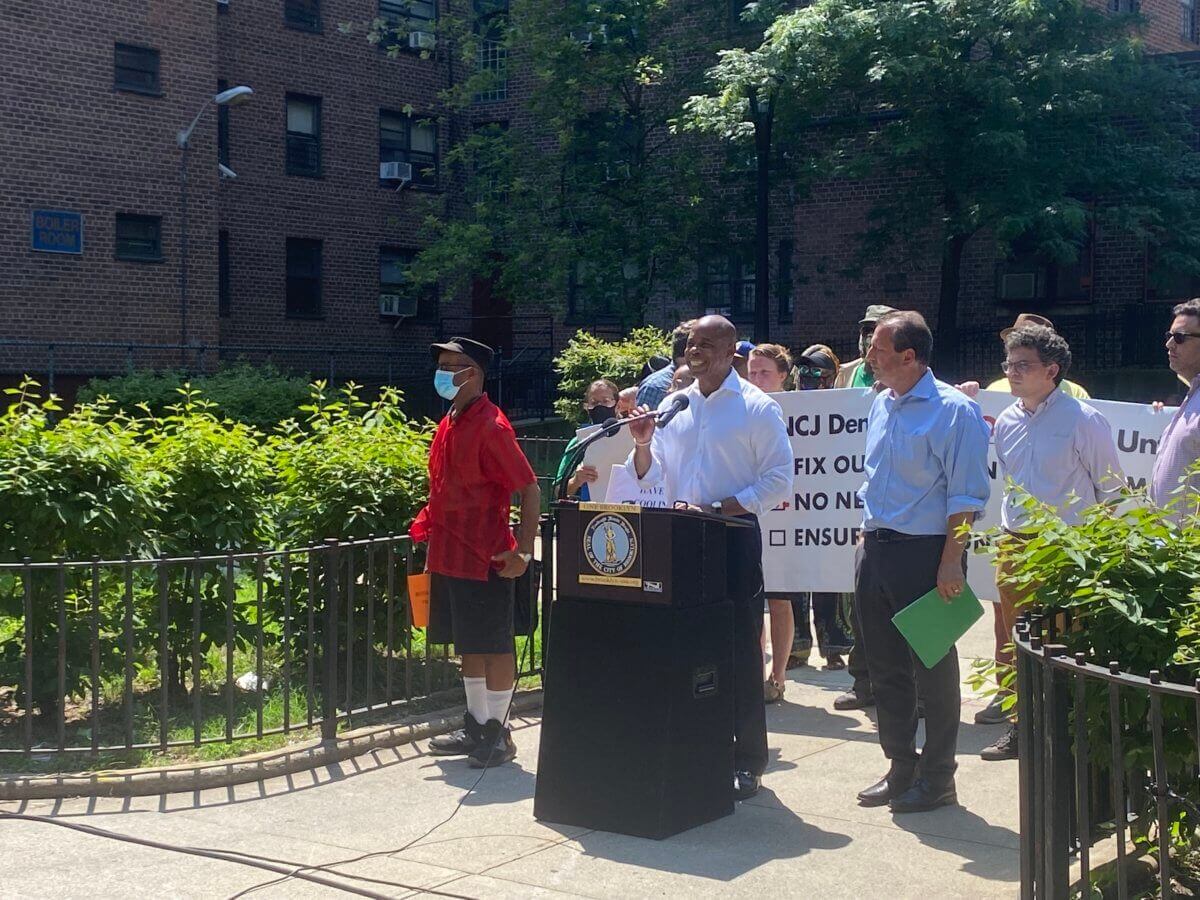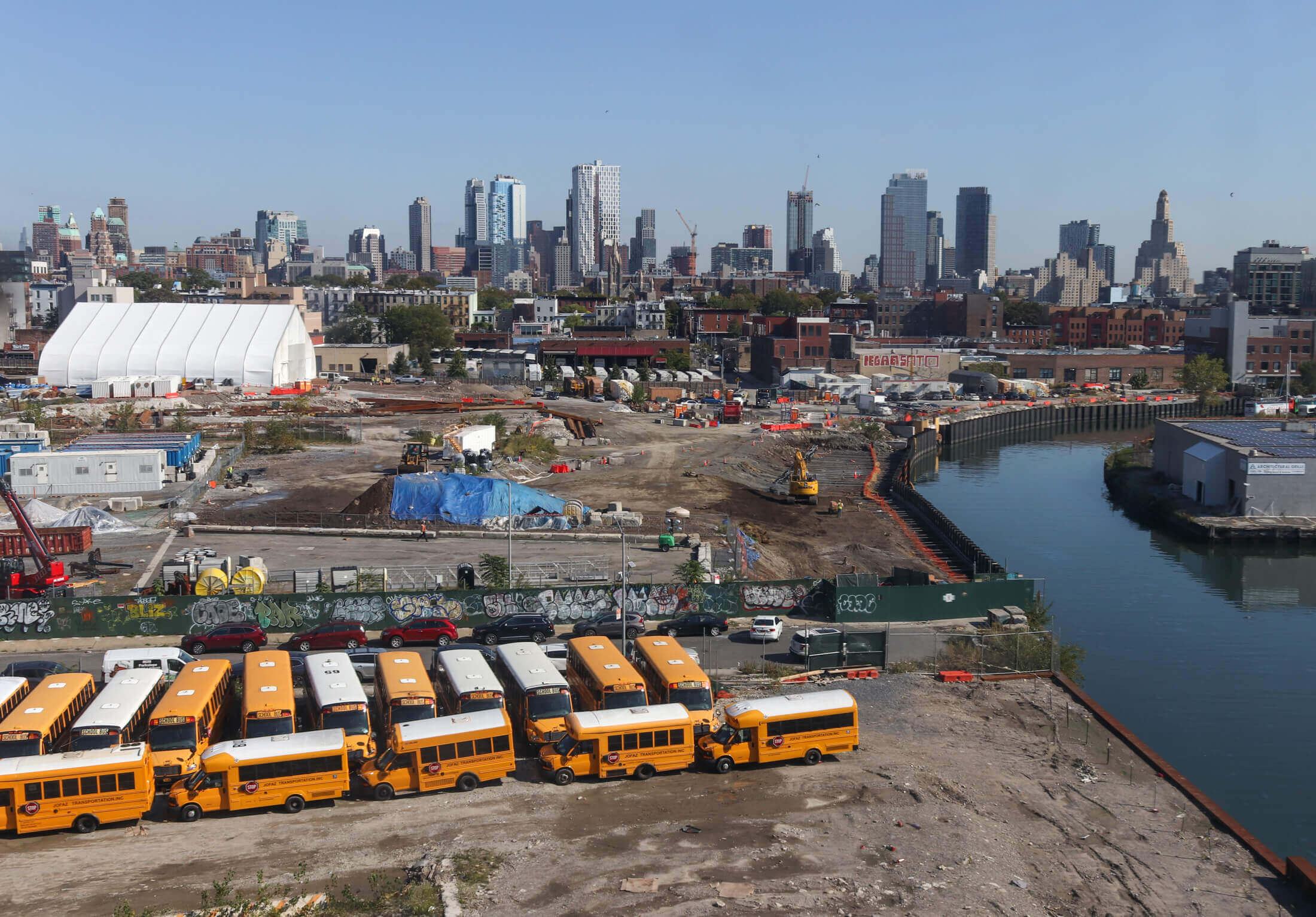City Council Hears From Locals, Pols on Controversial Gowanus Rezoning
The New York City Council held its hearing on the Gowanus Neighborhood Plan, questioning developers and heeding testimony from neighbors and stakeholders in a five-hour meeting.

Photo by Susan De Vries
The New York City Council held its hearing on the Gowanus Neighborhood Plan on Tuesday, questioning developers and heeding testimony from neighbors and stakeholders in a five-hour meeting as members prepared to take the first binding vote on the rezoning.
Activists, community members, and local government have been engaged in a months-long Uniform Land Use Review Procedure for the 82-block rezoning, headed by the Department of City Planning, with particular focus on the more than 3,000 promised units of affordable housing, the impact more than 8,000 new housing units will have on combined sewer overflow, and funding for long-needed improvements at two New York City Housing Authority complexes, Wyckoff Gardens and Gowanus Houses.
Thus far, the project has been voted down by Brooklyn Community Board 2 and approved with lengthy lists of conditions by CB6 and Borough President Eric Adams.

Both CB6 and the borough president included the three core demands of the Gowanus Neighborhood Coalition for Justice, including the creation of an independent task force to monitor the city and developers to ensure they’re carrying out commitments made during the ULURP process.
Karen Blondel, an organizer with the Fifth Avenue Committee, said during her October 12 testimony that past rezoning and construction work has proved the need for task force “with some bite.”
“With construction comes destruction, and in the case of Community Board 6, we have seen many trees cut down in response to resiliency processes,” she said.
The City Planning Commission voted nearly-unanimously to approve the project last month.
While Adams and CB6 are in agreement about how and why the rezoning needs to be altered, their votes and conditions are merely advisory, and do not technically need to be taken into account at the CPC, in the Council, or in the mayor’s office.
But Council Menbers Brad Lander and Stephen Levin, who represent the neighborhoods included in the rezoning, have said they will not vote for the project unless it includes GNCJ’s demands. The Council most often votes with the members who represent the affected communities.
“I said at the time of the release of Community Board 6’s thoughtful and extensive recommendations when they voted to approve with modifications that I would take them as marching orders when the proposal reached the council,” Lander said at the start of Tuesday’s hearing.

He understands why his constituents are skeptical of the rezoning, he said.
“But I continue to believe that — if we get it right, and there is still critical work to do — the Gowanus rezoning could be different, and could genuinely deliver a more inclusive, affordable, sustainable and economically vibrant neighborhood, right at the time we need it.”
Prioritizing NYCHA
Jonathan Keller, a senior planner with DCP, said the coronavirus pandemic further highlighted the need for what’s proposed in the rezoning — more open spaces, more housing and environmental justice.
“Our planning can give us hope when it’s flexible enough to respond to the unforeseen and permanent enough to stand the test of time,” Keller said. “And the Gowanus plan does this in response to the needs of today and the future.”
Francisco Moya, chair of the Council’s Land Use Committee, and Levin had the same question for DCP — why, after months of discussion on the importance of fully funding improvements at the NYCHA complexes, isn’t there a solid plan in place?
Keller said the department has been meeting with tenant groups, and that the administration is working toward a funding package.
“Was there ever any consideration to incorporate investment in NYCHA as part of the neighborhood plan from the early stages, or no?” Moya asked.
They hadn’t, Keller said, and the early-stage conversations had been “humbling” for the administration as community activists pushed for the plan to fund the complexes. He confirmed that the funding would be addressed in coming weeks, before the Council takes its vote.

Keller said that the department is considering holding regular check-in meetings with NYCHA residents.
“I’m taking that as a yes on the NYCHA-led resident oversight body on the NYCHA repairs, and that we will be able to codify that in the points of agreement going forward,” Lander said.
Cleaning up Public Place
Public Place, formerly the site of a manufactured gas plant and the future home of Gowanus Green, will be fully remediated and safe for tenants when it opens, said Mark McIntyre, general counsel at the Mayor’s Office of Environmental Remediation.
“We can have confidence that Gowanus Green, Public Place, as well as other places the rezoning would designate for housing can be safely remediated,” McIntyre said. “All these properties where housing is to be built will be brought to safe residential standards.”
National Grid is currently cleaning up the “hotspots” on the lot, where gas tanks used to be stored, McIntyre said, and DEP has applied to the environmental conservation department and the federal Environmental Protection Agency for a brownfield cleanup. Developers will do a second cleanup before construction begins.

But the site, located at 5th and Smith streets, may be needed as a staging site for the EPA’s ongoing Superfund cleanup of the Gowanus Canal. If the federal agency doesn’t find an alternate site, Public Place could be used “for years,” delaying the construction of Gowanus Green.
Lander had some suggestions for Gowanus Green and Mercy Home, a 43-unit all-affordable building planned for 4th Avenue and 12th Street under the city’s Urban Development Area Action Program.
He would like residents of CB2 and CB7 to be prioritized for affordable units at Gowanus Green alongside residents of CB6 — a change likely subject to “some litigation and policy debate,” he said.
“The community welcomed two family shelters just a couple of blocks away [from Mercy Home] on 4th Avenue,” he said. “And we’d like to see families who have their kids at the local public school, PS 124, who are there, have a priority option for the permanently affordable housing created.”
“I’m not even going to ask the administration about that, because, they’re going to give me, as much as they’re my friends, word salad about it. So I’m just going to ask my chairs to help me push hard for it.”
Preserving the Gowanus arts community
Behind the scenes, Lander has been working alongside local nonprofit Arts Gowanus on a Community Benefits Agreement that would benefit local artists.
David Kutz, board president of Arts Gowanus, criticized DCP for not studying the impact of the rezoning on artists in the DEIS because they classified artists as “freelancers” who don’t work full-time in their studios.
“I wonder, how does the DCP know what the business circumstances are for the artists in the neighborhood without a study?” he said. “How do they know that no mitigation is required?”
Johnny Thornton, the art organization’s executive director, said that they’ve reached a “preliminary agreement” with a few developers involved in the rezoning to provide at least 200 subsidized studios for artists.
“We’re hesitantly excited for the future of Gowanus if this should happen,” Thornton told Brooklyn Paper ahead of the hearing. “If Williamsburg took care of all of their artists 20 years ago, I think Williamsburg would be a much different place.”

“If a signed, ironclad contract is not completed by the time of the final vote, we believe this will be a death blow to the creative community in Gowanus.”
Preparing for climate change
Amy Motzny, watershed senior planner at the Gowanus Canal Conservancy, said the city should commit to additional measures regarding climate change and the rezoning’s impact on CSO output given the outdated modeling and inconsistent calculations included in the environmental impact statements — concerns flagged in a letter from the EPA.
Those measures should include a full hydrology study, she said, as well as ensuring that Gowanus is included in “cloudburst” studies, which would identify neighborhoods most at risk from sudden intense storms like Hurricane Ida.
While not part of the rezoning, Tuesday’s hearing also addressed the Owls Head CSO tank, a four-million-gallon water retention tank planned for the Salt Lot next to the 6th Street turning basin.
Owls Head and its sister tank, Head End, are designed to catch and store stormwater that would otherwise flow into the Gowanus Canal. Construction delays on the tanks violate federal Superfund orders, as they’re not expected to be completed until years after the EPA completes their cleanup.
Alicia West of the DEP confirmed to Levin that the tanks are scheduled to be completed in 2028 and 2030.
The same day as the hearing, Gowanus neighborhood coalition Voice of Gowanus said the city must halt the review process and redo the plan’s environmental impact statement, calling the rezoning proposal “legally non-compliant and premature” in a press release announcing the group has retained environmental lawyer Richard J. Lippes of Love Canal fame.
Status quo?
As the hearing wound down, Lander emphasized the way the community has already changed the project — increasing the number of affordable units at Gowanus Green, pushing for new schools and transit improvements.
“We know what the status quo looks like,” he said. “If this rezoning is rejected, we will not get 3,000 units of genuinely affordable housing. We won’t get significant investments in public housing. I think we’ll miss the opportunity to make some new and significant stormwater investments alongside the Superfund, which will continue on its own.”
“We just really have to grapple with that.”
The Council must make a decision on the rezoning within 50 days of receiving the CPC decision, and is expected to vote before November 15.
— Additional reporting by Cate Corcoran
Editor’s note: A version of this story originally ran in Brooklyn Paper. Click here to see the original story.
Related Stories
- City Planning Greenlights Controversial Gowanus Rezoning
- Local Pols Want Gowanus Rezoning Halted Pending Further Study
- Eric Adams Puts Support Behind Gowanus Rezoning, Pending Investment in NYCHA
Email tips@brownstoner.com with further comments, questions or tips. Follow Brownstoner on Twitter and Instagram, and like us on Facebook.





What's Your Take? Leave a Comment